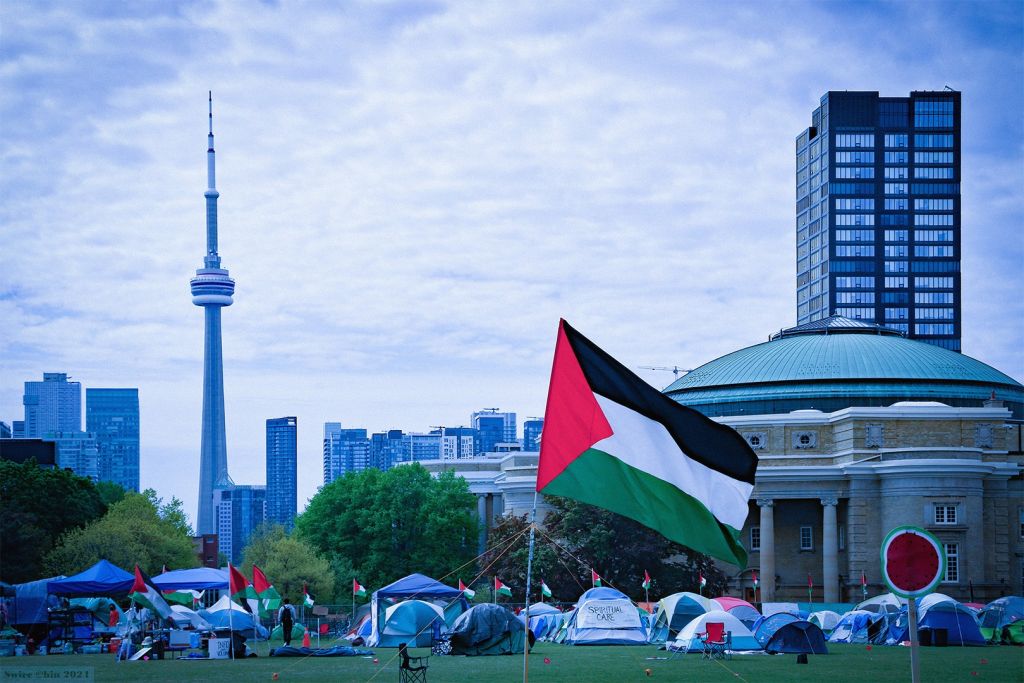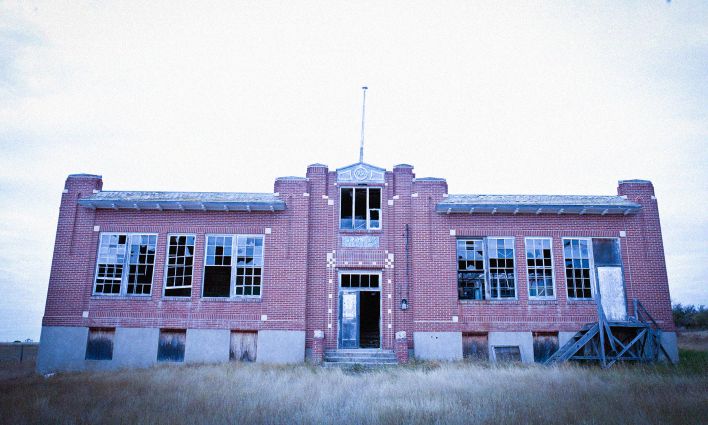It has been described as the world’s first live-streamed genocide. At the time of this writing, the Israeli army has killed over 36,000 Palestinians in Gaza, including at least 15,000 children. The strip’s population is trapped behind closed borders, under deliberate siege, and reaching mass-starvation levels of hunger. The vast majority of Gaza’s inhabited zones have been destroyed. Western countries, led by the United States, continue to support Israel, even as it faces charges of genocide in the International Court of Justice (ICJ).
University students across the globe have showed their solidarity with Palestinians by occupying a part of their university spaces and demanding the university administrations disclose their financial investments in Israel, implement an academic boycott on Israeli universities, respect the right to protest on campus, and adopt a definition of anti-Palestinian racism, alongside other demands unique to each campus.
These protests have become lightning rods in public discourse—and a lot of that discourse is filled with misinformation. I have had the privilege and opportunity to be part of the participating organizations from Carleton University at the University of Ottawa encampments. From the ground, let’s take apart some of the more common misleading claims.
MTYH: Students are trespassing on university property.
REALITY: The right to protest is protected under the right to “freedom of expression and peaceful assembly” under the Charter of Rights and Freedoms. Despite such legal protections for student’s rights to protest, universities’ attempts at repression have contributed to the narrative that the encampments are illegal.
Whether university land can even be considered private property—considering the fact that they are publicly funded institutions—remains a matter of legal debate, with contradictory rulings from different levels of various court jurisdictions.
That hasn’t stopped universities from acting to repress students’ right to speech. Edmonton police raided the University of Alberta’s encampment on May 11 because there were “safety concerns, [and] signs of entrenchment.” University of Alberta had been in contact with EPS since May 9, the start of the encampment. The encampment was peaceful and remained peaceful until police violently removed the students.
In Quebec, courts rejected two injunctions against McGill’s encampment. The first, based on the lack of evidence demonstrating the “threatening” nature of the encampment and confirming that the students are still able to access university buildings. Justice Chantal Masse agreed that the campers are illegally occupying university property.
McGill’s administration filed a second injunction after failed negotiations with encampment organizers, claiming that campers are illegally occupying the university property and impeding convocation. The court rejected the injunction because the encampment remained peaceful. Despite calls from politicians to involve the Montreal police, even the police department says that the peaceful encampment has no reason to be dismantled because it is within the rights of the students and supporting community members to protest. Those police did, however, attack students who briefly occupied the university’s administration building on June 6 using tear gas, batons, and pepper spray.
Organizers at the University of Ottawa have held down their encampment for over a month. In a recent statement, the university’s president, Jacques Frémont, called the encampment illegal, and claimed—without evidence—that he does not believe that these protest encampments are protected by freedom of expression. Frémont would like a “peaceful end” to the protest—something he could achieve if the university he manages took a strong stance against the genocide in Palestine.
Carleton, for its part, has created anticipatory policies to prevent encampments. On May 10, the university released a policy update under “Conference Services Space Booking and Use Policy” explicitly stating “that camping and/or structures are strictly prohibited on university-owned or managed property.” This policy is an attempt to repress students’ right to freedom of expression and peaceful assembly, but has no legal grounds.
MYTH: Sure, student protests might work for student issues like tuition fees—but they don’t work for international issues.
REALITY: Universities are places for debate and critical thought, and have a long history of student activism and international solidarity. Domestic and (especially) international student's tuition fees supplement the public funding universities receive from provinces—and universities use these tuition fees investments, including pension plans, and (non)endowed funds. Students want that money—their money—to stop funding genocide. This is a student issue.
It’s also not the first international organizing campaign on campuses. Carleton University divested from South African companies complicit in apartheid in 1987 after pressure from the Carleton Anti-Apartheid Action Group (CAAAG). Students launched a campus-wide campaign to pressure “boycott [of] South African goods, notably food, beer, and cigarettes,” while lobbying the university administration. Although Carleton University was a drop in the ocean of investments in South Africa, CAAAG understood that their tuition fees were used to support apartheid, so they recognized they would be most effective in their campaign by trying to have the university redirect their investment funds out of apartheid South Africa.
During this time period many other universities divested from the apartheid government of South Africa which “played a fundamental role in the ultimate dismantling of the apartheid state, spawning institutional and governmental pressure beyond just educational Institutions.” Students for a Free Southern Africa at the University of British Columbia achieved a partial divestment from South African investments in 1986 by “withdrawing exclusively from companies that did not adhere to Canadian business protocols”.
MTYH: These protests are anti-semitic because they’re making Jewish students feel unsafe.
REALITY: Weaponizing allegations of anti-semitism against criticisms of Israel to deter any productive conversation of Palestine is a standard tactic that supporters of the Israeli state use. In this case, it’s important to remember that alongside the Palestinian student groups organizing the encampments are progressive Jewish groups, such as Independent Jewish Voices. Many of the protesters are, themselves, Jewish.
Nir Hagigi from Independent Jewish Voices (IJV) Carleton University chapter told CBC radio that the encampments are filled with love and support from the community. Nir references the Jewish value of tikkun olam, which means repairing the world—and follows it by standing in solidarity with those who are marginalized.
Encampments are not supposed to be a comfortable experience, protesting is supposed to be uncomfortable because Palestinians are dying at an unfathomable rate in such a violent way. Being uncomfortable is not the same as being unsafe.
MYTH: The term “Intifada” is a call to violence against Jews.
REALITY: Many student protesters and their supporters have referred to their movement as the “student intifada,” or held banners or shouted slogans using the term. The term Intifada means “uprising” or “shaking off” in Arabic, and has been used in a variety of contexts to describe mass movements against oppression—allegedly first used in the 1952 “Iraqi Intifada” against that country’s former monarchy. Mostly, today, it refers to resistance in Palestine against the Israeli occupation.
The First Intifada, which lasted from 1987 until 1993, was also called the Stone Intifada, because that is what Palestinians were armed with against Israeli tanks and snipers. The First Intifada ended with the Oslo Accords in 1993, which were meant to pave the way for a two-state solution.
The second Intifada or “Al-Aqsa” Intifada lasted from 2000 to 2005 and came as a result of a scheduled visit of Israeli opposition leader, Ariel Sharon to the Al-Aqsa mosque. Israeli soldiers' in Jerusalem opened fire on Palestinian protests. Unlike the mostly non-violent resistance of the First Intifada, the Second Intifada saw Palestinian resistance groups take armed action against Israeli occupation forces as well as non-combatants. Over the course of the Second Intifada, Israel killed 5,000 Palestinians and injured over 50,000.
Both Intifadas were a reaction to Israeli colonial violence that Palestinians were and continue to be subjected to. Palestinian resistance has taken on many forms, from mass nonviolent action—most recently, in 2019, when thousands of Gazans peacefully marched to the militarized enclosure wall at the edge of the Gaza strip, only to be fired upon by Israeli snipers—and armed action, as in the Second Intifada. Today, the term represents a general call to action in the struggle for Palestinian liberation, and not a call to any specific set of tactics. Reducing this to “violence against Jews” is a deliberate misreading of the history of the term.
MYTH: The students are making it all about themselves—we should be centering Gaza, not privileged university kids.
REALITY: Student solidarity is important and should not be disregarded. There is no single correct way of protesting—different people resist differently based on where they are situated
In the case of the encampments, students have strategically chosen to occupy their campus, where even during the summer semester with a reduced student population, administration continues to work. They are making demands that align with the boycott, divestment, and sanction (BDS) movement—which was started by organizers in Palestine. Student groups recognize that the universities where they learn about human rights and social justice are investing in Israeli companies that are either manufacturing weapons or illegally occupying Palestine—and they want it to end. These students are heeding the call from Gaza, not centering themselves.
MYTH: Students would be better off operating through official channels to win their demands.
REALITY: Before the first Palestine solidarity encampment planted tent stakes in the ground in Canada, student groups had been working for months and years to bring divestment to the table. Prior to the encampments, university administrations generally used a predictable playbook of tactics to prevent any sort of meaningful dialogue:
Delayed or no email replies to requests for meetings.
Delayed or denied access to information requests through internal university mechanisms. The appeal process through the province takes months at a time.
Meeting with student organizers under the presumption that administration is willing to cooperate, but instead wastes the energy and time of students.
Threatening Palestinian student organizations with disciplinary investigations to dissuade any direct action.
Waiting for student organizers to graduate.
University administrations played a game of endurance, and continue to do so during encampments. Encampments were the last resort for students to gain the attention of university administration because Gaza cannot wait.
The simple solution for the encampments to disappear is for university administrations to satisfy the demands of divestment. Ontario Technical University on May 20 ended its encampment because they came to an agreement with their university administration—as did UQAM in Montreal on June 6. If university administrations are frustrated with the encampments, then divest.
MYTH: Students at smaller universities without an encampment are doing nothing for the cause.
REALITY: Organizers at smaller universities, such as Carleton University, Algonquin College and Saint-Paul University in Ottawa, made the strategic decision to collaborate and support the larger universities, like the University of Ottawa. They made this decision based on a number of factors, including the fact that the summer semester means many students are not in the city to support the camps.
Carleton University campus, for example, is isolated from most of the city, while the University of Ottawa is located downtown, in a more strategic location for visibility—so Carleton students have been supporting the University of Ottawa encampment. Supporting larger campuses sets a strong precedent for smaller campuses to leverage their work—a win at the University of Ottawa would make a win at Carleton more likely down the line. Just because there isn’t an encampment happening on some campuses does not mean student organizers are not doing the work.
Why now?
I first engaged in Palestine solidarity activism in 2021, at a time when “evictions” of Palestinian families in occupied East Jerusalem—so that Israeli settlers could move into long-time Palestinian family homes—kicked off a series of protests, which Israel put down using force. That year, Israel bombed 1,500 targets in Gaza and killed 120 Palestinians, according to Human Rights Watch. People’s attention, however, waned quickly.
In 2024, Israel is violently killing, arresting, and torturing Palestinians on an unprecedented scale, and people are demanding the liberation of Palestine through sustained action. Many new people have also joined the struggle to free Palestine.
This time, we are in it for the long haul.
Encampments are a microcosm of the worldwide outcry against the genocide of Palestinians. Organizing is imperfect and it is a learning process. There really is no handbook on how to do this. But across campuses, from Columbia to the University of Ottawa, students have shown that there is nothing to fear—and that the diplomatic, liberal methods of communication aren’t effective, but collective action is. Palestine has been occupied for the past 76 years, and as long as Palestine is not free, there will be a movement in solidarity with Palestinians.
Universities must disclose and divest or else the students will not stop or rest. It’s time for Canadian universities to stand on the right side of history.







